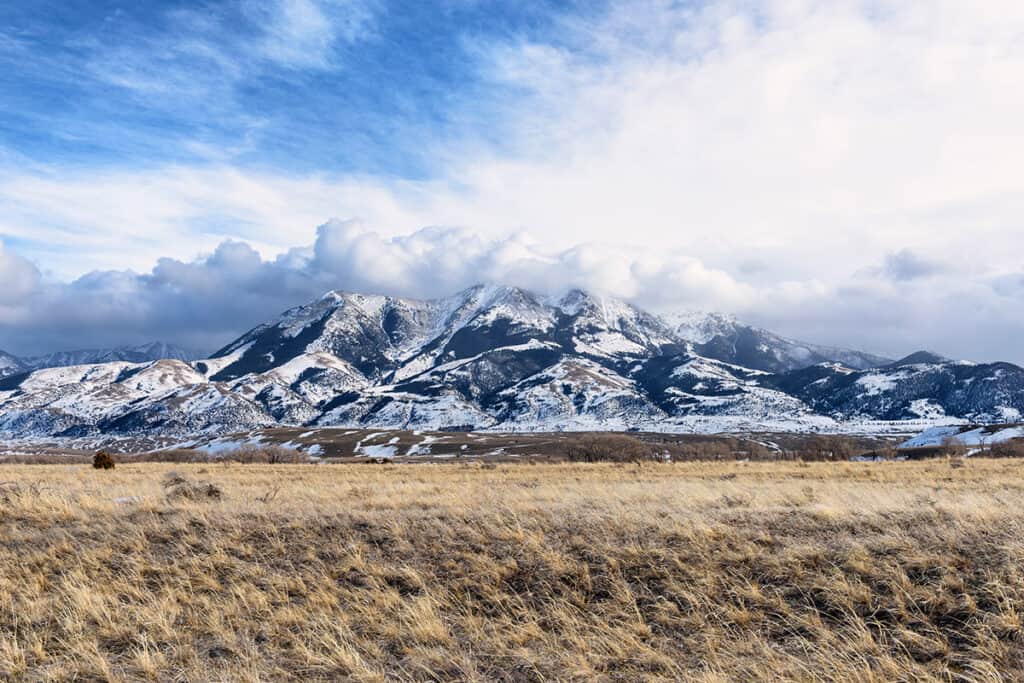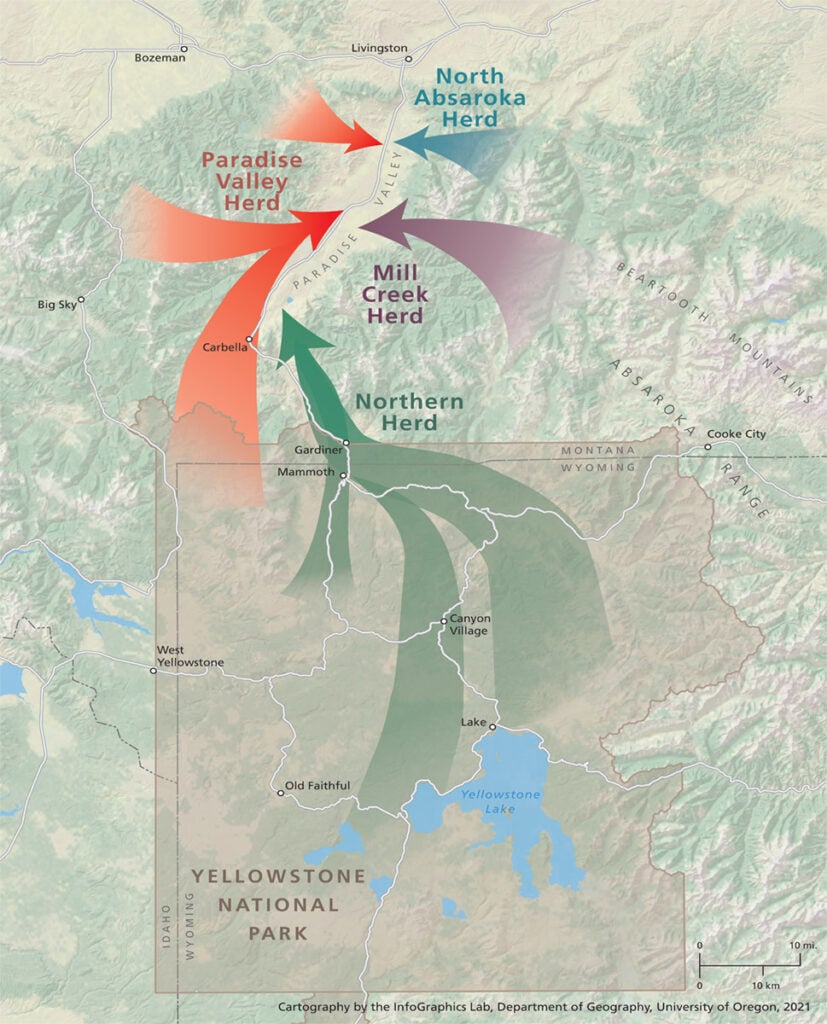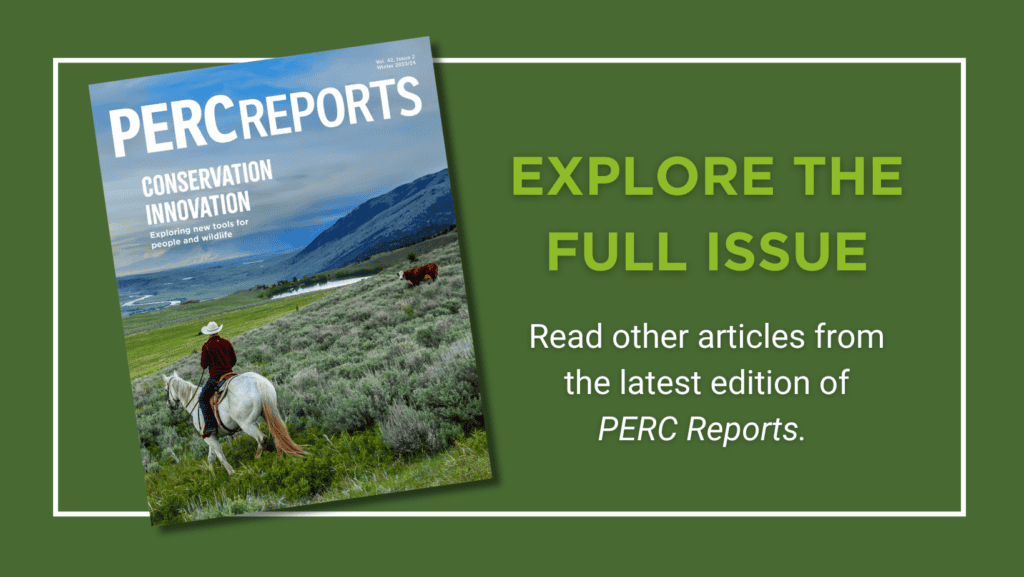
This special issue of PERC Reports features several pilot projects from PERC’s Conservation Innovation Lab. Read the full issue.
Montana’s Paradise Valley is not only a rural landscape with deep-rooted ranching traditions, scenic views, and ample recreational opportunities located at the northern gateway to Yellowstone National Park. It’s also ground zero for PERC’s Conservation Innovation Lab.
Surrounded by national forest and a scattering of other federal and state lands, Paradise Valley and its several dozen cattle ranchers support abundant populations of wildlife, including mule deer, bighorn sheep, and elk. Likewise, populations of carnivores like gray wolves and grizzly bears are expanding here. Hikers, anglers, hunters, and kayakers also enjoy the countless trails, streams, and open spaces on offer. In the middle of the valley, the epic summit of Emigrant Peak towers over the flat and fertile banks of the Yellowstone River. The backdrop for it all, however, is growing economic pressure to subdivide intact landscapes.
Much of the stewardship responsibility and financial burden for providing essential wildlife habitat falls on private landowners, who own roughly half of the land in the valley. Yet ranchers and other landowners often feel their contribution is ignored, or worse, taken for granted, with potentially earth-shattering consequences. You don’t have to watch “Yellowstone” to know that this part of Montana faces very real and growing development pressures. An omnipresent tourism industry, red-hot demand for ranchettes that fragment the landscape, and desires to build sprawling subdivisions threaten to transform the valley’s open lands. Each would have its merits and benefits, but the fact remains: If these ranchers fail, then conservation of these landscapes will fail. That’s why it’s vital for the conservation community to help them succeed by pioneering innovations that compensate these ranchers for the work they’re doing.
In 2019, PERC began to carry out surveys and interviews and hold public meetings with the Paradise Valley ranchers whose stewardship of land, water, and wildlife plays a vital role conserving the landscape. Our 2020 report “Elk in Paradise: Conserving Migratory Wildlife and Working Lands in Montana’s Paradise Valley” documented the attitudes of these ranchers toward their land, their livelihoods, and the area’s wildlife. When asked, “Do you suffer economic impact from wildlife on your property?” 81 percent of surveyed landowners responded in the affirmative, and the species in question was overwhelmingly elk.

“Elk are constantly knocking down fences,” said one rancher, “allowing our cattle into the wrong pastures. They come down at night and are decimating the pastures we reserved for grazing our cows. We have to buy more hay every year because we’re not able to save grass for the cows.” In addition to competing with livestock for forage and hay and damaging fences and other property, the report noted another huge concern for ranchers in the region: the threat of transmitting brucellosis to cattle. The disease can ravage a herd’s cows, and the mandated quarantine that an outbreak requires can financially ruin a ranch. Additionally, multiple landowners voiced the sentiment that larger herds of elk spend more time on private lands these days. Perhaps most worryingly, many felt that the public ecological benefits they provide were taken for granted by state and federal agencies, recreationists, and the wider public who shape wildlife policy.
The report’s findings were clear: If the working lands of Paradise Valley are vital for sustaining populations of elk and other wildlife, then more must be done to embrace, encourage, and compensate private landowners to ensure those lands remain part of the valley’s conservation portfolio.
The following three features in this special issue of PERC Reports detail the three Paradise Valley projects that laid the foundation for the Conservation Innovation Lab. First, Kat Dwyer chronicles the groundbreaking elk occupancy agreement that PERC pioneered with the Petrich family ranch. Whitney Tilt then unpacks the perils of brucellosis and describes PERC’s effort to provide a financial safety net for the valley’s ranchers. Finally, Todd Wilkinson reports on our latest effort to compensate landowners for stewarding elk habitat, through an innovative payment-for-presence scheme that harnesses remote cameras and artificial intelligence.
These initiatives were built on decades of work applying market-based principles to environmental problems. Our ongoing work in Paradise Valley set the stage for a more formal and systematic approach to applying our solutions to the real world. Ultimately, it helped turn the Conservation Innovation Lab into “the third leg of the PERC stool,” complementing the two long-standing legs of robust research and influential policy analysis.
Paradise Valley is a special place for the wildlife that forages here, the ranchers who live here, and the PERC team members who are so deeply committed to its future. Our work here has implications far beyond this remote corner of Montana. If we can successfully harness markets and incentives to address the vexing challenges in this valley, we can create a new path forward for conservation.



